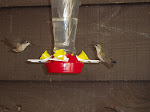Anyone with wood siding has no doubt heard that familiar ratta-tat-tat as winged hammers excavate crater sized holes in the sides of our houses.
Contrary to public belief, they are not torturing us just for fun; they are really enjoying a gourmet dinner at its finest.
There’s nothing like a warm, fat bug on a chilly winter’s day. That’s right, long thought of as pests, woodpeckers & flickers are actually ridding our homes of the true pests; wood-boring insects.
I wouldn’t be too quick to rule out revenge though. After all, its us who rob them & other birds of their best high energy food sources every time we remove a dead tree, clear a weedy field or bury our dead livestock.
We could always offer up road kill at our feeders as a deterrent to pecking at our homes but somehow the sight of a dead something or other hanging outside the window doesn’t seem too appealing. Not to mention the cult rumors that would spread if the neighbors were to see dead, mutilated creatures dangling from your trees!
A more civilized solution is to serve suet, either pre-made cakes or beef fat (pork is too salty) obtained from the butcher cheaply or free.
Suet chunks can be nailed to trees or hung in commercially made suet cages or mesh onion bags.
For the more creative types, the fat can be melted & used in a variety of ways.
Pine cones make excellent & natural suet feeders.
Simply pour semi cooled fat over an upturned cone, fill the nooks & crannies, let it harden, attach a screw to the flat end & hang it from a branch with string or ribbon. Chickadees & nuthatches will love it.
Seeds nuts, cracked corn, millet, raisins & so on can also be added to the semi cooled suet.
Another method is to smear suet mixes in to the crevices crotches of trees.
My personal favorite & by far the most popular in our yard, is the suet log.
This particular feeder brings in the greatest variety of meat eaters, with as many as a dozen different kinds of birds dropping in for their daily dose of cholesterol.
We have three suet logs, each a foot long, about four to six inches around. The branches were cut down to two inch stubs to act as perches. Above each perch, a hole, an inch & a half wide & at least one inch deep has been carved or drilled & filled with suet.
A heavy duty screw & wire are needed to hang this type of feeder as a couple of flickers chowing down at the same time makes for a lot of extra weight.
Place all feeders out of reach of pets & prevailing winds but where you have the best view.
You may even be as lucky as I was to see a Hairy & a Downy Woodpecker sharing the same log feeder.
Real luck though, would be finding my camera in time to get a picture!
Subscribe to:
Post Comments (Atom)
.png)






No comments:
Post a Comment